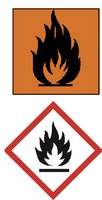
From 1. June this year begins the transition from the well-known orange danger signs to new red-white CLP signs on a wide range of building materials. Dana Lim’s laboratory manager Erik Andersen gives you a quick overview of what the CLP rules mean for you.
The new global CLP labeling scheme for chemicals and mixtures will be phased in in Denmark from 1. June 2015. First of all, the new labeling system means that the well-known orange danger labels will in future be replaced by red and white CLP labels, which from 1. June 2017 will be the only legal hazard signs.
Transition period from 1/6-15 to 1/6-17
The phasing in of the CLP labeling takes place over a two-year period from 1. June 2015 to 1. June 2017. During the transition period, products and materials that are out in the shops before 1. June 2015 with the orange danger marks, still willing to sell and buy. But products and materials, which only hit the shelves after 1. June 2015, must be provided with red and white CLP labels.
– You can therefore with a clear conscience sell and use products with orange danger marks until 1. June 2017, as long as the products are only out on the shelves before 1. June 2015, explains laboratory manager Erik Andersen from Dana Lim.
Not a 1:1 translation
In addition to the fact that the orange hazard labels on materials and products are now to be replaced by the red and white CLP labels, the CLP labeling also means that the so-called R and S phrases (risk and safety phrases), which are linked to the hazard labels, changes slightly. Erik Andersen elaborates:
– The new CLP labels and phrases are not 1:1 translations of the old ones, as some of the criteria and limit values change. This means that you e.g. may find that products, which were previously not provided with a hazard label, must now have a CLP label. The reason is that the CLP labeling scheme works slightly differently to the old scheme, not that the products have changed.
Good news for allergy sufferers
In addition, Erik Andersen points out that in connection with the new CLP labeling it will be easier to be an allergy sufferer. The CLP labeling scheme implies that there will be more information on the products, than there has been previously, regarding substances that can trigger an allergic reaction.
– It will be like on the oatmeal package, where you can read today, that the product may contain traces of peanuts. It is vital information for nut allergy sufferers, while in practice it means nothing for non-allergy sufferers, explains Erik Andersen and continues:
– The CLP labeling scheme represents a big step in the right direction, as allergy sufferers will in future be able to clearly see on the products whether they contain substances that they may have a reaction to. In this connection, the CLP labeling scheme is a welcome helping hand, which will make it easier for allergy sufferers to see which products they should steer clear of.

